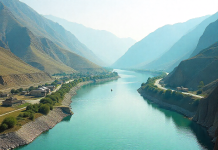BY Abdul Rashid Shakir
Improving macroeconomic indicators like lowering inflation and policy rates;growing GDP and foreign exchange reserves; rising remittances and exports; and shrinking twin deficits of trade and current account lead to microeconomic stability, resulting in increasing investors’ confidence; accelerated economic activities; surge in GDP growth rate; and improving public spending in education,health and entertainment.Pakistan, in the first year of PML-N led coalition government, has taken major strides in all sectors of economy, not only shielding the country from potential perils of impending default but ensuring its quick take off through ‘Uran Pakistan,’ anambitious 5Es-based roadmap of economic transformation by focuses on improving exports, equity, energy security, environmental protection and e- governance. Government has reduced inflation from 38% to 4%, and policy rate from 23% to 12%; has increased GDP growth rate from 0.29% to 2.38%, projected to reach 3.5% in FY25; has improved foreign exchange reserves from $4.4 billion to $11.7 billion; has lowered trade deficit from $27 billion to $17 billion; and will save approximately Rs 1.7 Trillion in Government expenditures over the next 10 years due to pension reforms (Pakistan Reforms Report 2025: Mishal Pakistan, Country Partner Institute of the World Economic Forum, 09 February 2025).
All the above- mentioned initiatives along with several regulatory reforms under SIFC (Special Investment Facilitation Council) have invoked investors’ confidence in the country’s economic turnaround, translating into Pakistan Stock Exchange (PSX) crossing a record of 100K points to become one of the best performing stock markets in the world (CNN Business).
The revival of CPEC Phase-II is another major breakthrough for the establishment of SEZs (Special Economic Zones), relocation of labor-intensive Chinese industries to Pakistan and mechanization of agriculture, leading to the creation of a number of employment opportunities and socio- economic development of the people. Perfectly in sync with the economic policies of the federal government, Punjab Government has introduced many projects for the development of infrastructure 2 and welfare of its almost 128 million people, more than 65% of which are below the age of 30 (7th Population & Housing Census, Pakistan Bureau of Statistics).
Under the visionary leadership of its vibrant Chief Minister Madam Maryam Nawaz Sharif, Punjab is investing liberally in productive education and rewarding training of its youth, not only in the traditional skills but also in the cutting-edge technologies like artificial intelligence (AI), robotics, augmented and virtual realities (AR/VR), quantum computing, green technologies (solar and wind energy), semiconductors and new energy vehicles (EV).
Government’s schemes like Early Childhood Education (ECE); Lahore Kindergarten School, besides plans to establish kindergarten schools in other districts too; Chief Minister’s School Nutrition Program which was started by providing tetra pack milk packs to more than four lakh students in 3527 schools of Dera Ghazi Khan, Rajanpur and Muzaffargarh; launch of a special campaign to ensure access to education for out-of-school children; introduction of spoken English and character-building classes, besides “Theme of the Month” in schools show Government’s commitment to develop well-rounded personalities of its younger generation, because these initiatives will not only equip them with critical thinking and communication skills but with the ethical values too.
Honhar Scholarships worth Rs 25 billion; prizes worth lakhs of rupees for position holders of the education boards, besides paying all their educational expenses;free Laptops worth Rs 10 billion, CM Skills Development Program to provide training to students in advanced IT courses in the fields like cloud computing,cyber security, data analytics, graphic designing, artificial intelligence, machine learning and game development are testament to Government’s commitment to the capacity building of its human resources to turn them into productive asset for socio-economic development of the country. Punjab School Education Department’s introduction of 04 new subject groups of health sciences, agriculture, information technology (IT) and entrepreneurship for matriculation examinations, besides the traditional science and arts streams; the establishment of Modern EdTech schools by the Punjab Education Foundation; and above all, the merit-based appointments of education officers are vivid examples of Government’s sincerity to not only improve upon the quality of education system in the province, but to provide students with expanded career- oriented options as well.
3 Public School Reorganization Programme (PSRP) which would not only save Rs.40 billion but would create employment opportunities for 70,000 youth; establishment of 5,000 new classrooms in PSRP schools, besides setting up STEM, IT and science labs in 1,000 elementary schools of the province; instalment of solar-powered charging stations in colleges; increase in the number of students in schools by several hundred percent by outsourcing them to well-reputed educationists and school chains; launch of a pilot project of satellite internet in DPS Model Town Lahore; launch of an internship programme benefiting 3,527 schools in South Punjab, besides the biggest higher education internship program in the history of Punjab under which 7354 college teacher interns were recruited in government colleges of the province @ Rs.50,000 per month for six months; provision of free e-bikes to one lakh students, and buses to girls’ colleges in every tehsil; plans to hold a school hockey league and Pakistan’s biggest “School Olympics” in Punjab are some of the other flagship initiatives of Punjab Government for the improvement of learning outcomes of the younger generation. Pakistan’s first ‘Nawaz Sharif IT City Lahore is nearing its completion. Major tech giants of the world are ready to join the project to spur IT revolution in the country, contributing a lot to the development of the IT industry and IT exports. During Chief Minister Punjab’s recent visit to China in December 2024, Gobi Partners, a leading venture capital firm in Asia, announced the launch of a $50 million Fund to boost startup ecosystem to foster innovation and economic growth in the province.
Besides her plans to offer international scholarships for Punjab’s youth to pursue higher education at prestigious global institutions, Punjab Chief Minister has also announced to establish an education city in Nawaz Sharif IT City, aimed at attracting top global universities to set up their campuses there.

















